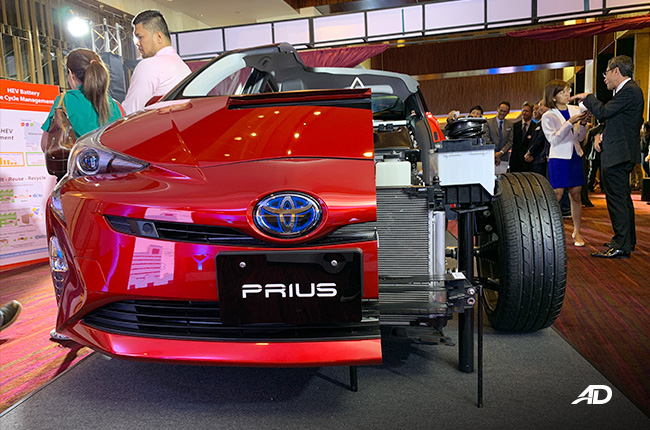
There has been a silent war going on in the Philippine automotive market, and it’s set to electrify the competition between the popular carmakers in the country.
Big brands like Nissan Philippines has started the flame with the news of the LEAF coming in by 2020. It was a piece of big news, at least on our end, because finally the Philippines will have its representative in the fully electric vehicle segment – and it’s one of the best-selling EVs in the world, mind you. However, other companies have something else in mind, particularly Hyundai Asia Resources, Inc. which undercut Nissan in the race to bring EVs here. Showcased at this year’s Manila International Auto Show, the South Korean carmaker debuted the Kona EV to join the Ioniq Hybrid in its range of electrified vehicles.
With this heated competition in place, what does the country’s no.1 car brand have in store for the electric vehicle market? The recent Toyota Hybrid Electric Technology Conference gave us some answers.
As the title suggests, Toyota Motor Philippines is sticking to hybrid technology or what it affectionately calls the Hybrid Electric Vehicles (HEV). The Prius and Prius-C are the forefront of TMP’s HEVs but I guess the burning question here is: Why? Why not go full EV instead just like other brands?
TMP President Mr. Satoru Suzuki cares to give us a brief yet meaningful answer.
Toyota has a whole range of electrified vehicle (xEV) technology that can help achieve sustainable mobility goals. But xEV polarization depends on many factors and varies by market. Based on current Philippine conditions, it is most appropriate to start with HEV popularization in order to accelerate the reduction of emissions and fuel consumption.
On the conference, it was explained that electrification takes a long and tedious process that involves not only the carmaker but also the government. In order for full EVs to completely promulgate in the market, infrastructures that support the technology (also known as EV chargers) should be strategically created. Price is one thing, but the anxiety of not finding a charger for your EV during a long trip isn’t a welcome thought – and that problem isn’t going to solve itself overnight. As mentioned before, there needs to be cooperation between the government, some privately-owned organizations, and the brands themselves in order for this to succeed.
In short, TMP’s keeping it real when it comes to vehicle electrification in the Philippines, and we sure do appreciate the honesty from the country’s no.1 brand.
Electrification is good, at least in the emissions standpoint, but HEVs can be implemented sooner – all while producing fewer pollutants than regular internal combustion engine-powered cars. TMP plans to eventually bring its Battery Electric Vehicles (BEV) in the Philippines as infrastructures that support the cause progress. But for now, HEVs will be Toyota’s bet on the EV bandwagon.
Latest News
-
Geely’s EX2 EV headed to Australia — is a Philippine launch possible? / News
The Geely EX2 is confirmed to go on sale in Australia in 2026. Could a launch in the Philippines also be on the cards?
-
Hyundai Motor Philippines is the FIFA Futsal Women's Teams' official mobility partner / News
Hyundai Motor Philippines strengthened its partnership with FIFA through its support of the FIFA Futsal Women's Teams.
-
Kia Philippines backs EJ Obiena as Atletang Ayala continues championing Filipino athletes / News
Kia Philippines strengthens its support for EJ Obiena, backing the Olympian with dedicated mobility at home and abroad.
Popular Articles
-
Electric Vehicles in the Philippines for under P1 million
Jerome Tresvalles · Aug 19, 2025
-
Top 3 Cars For Every Lifestyle—What Cars Are Right For You? | Behind a Desk
Caco Tirona · Apr 24, 2024
-
5 Tips to Maximize Fuel Efficiency
Jerome Tresvalles · Sep 09, 2024
-
Five driving habits that are draining your fuel tank
Jerome Tresvalles · Jun 24, 2025
-
Can engine braking harm your engine?
Jerome Tresvalles · Sep 11, 2025
-
Do electric cars even need maintenance?
Jerome Tresvalles · Oct 23, 2024
-
Best vehicles for an active outdoor lifestyle
Shaynah Miranda · Jul 25, 2024
-
How to drive different types of vehicle transmissions
May 23, 2024
-
5 easy ways to keep your car interior clean
Allysa Mae Zulueta · Nov 15, 2021
-
How to survive Metro Manila traffic
Earl Lee · Aug 16, 2022









